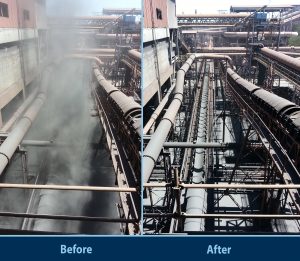
Many bulk material handlers think of combustible dust as a housekeeping item. Once enough of it gathers in one place, they’ll assign personnel to clean it up.
What they might often overlook are the combustible dust hazards. The Occupational Safety and Health Administration (OSHA) defines combustible dusts as “fine particles that present an explosion hazard when suspended in air in certain conditions.” They have great potential to cause or contribute to a fire, a flash fire or an explosion. Plant staff also can inhale them and develop long-term health problems. Combustible dusts can interfere with maintenance of process equipment as well.
Some plant operators might say, “It’s never happened here before,” or “It will never happen here.” They may not realize they’ve been getting by on luck. But when that luck runs out – and often it will – it affects both people and property, and the business takes a hit.
It’s always better to know and be proactive about the hazards of combustible dust. Industries such as coal, biomass, wood pellets, cement, paper, rubber, wood-product processing and agricultural have combustible dust hazards. If left alone, small amounts of build-up can develop into a big and menacing problem. Effective and thorough dust management reduces personal and material risks and reinforces a more productive and profitable business.
NFPA 652 and DHA
Both plant management and maintenance personnel should review National Fire Protection Association (NFPA) 652: Standard on the Fundamentals of Combustible Dust, which outlines proactive practices for preventing and decreasing combustible dust hazards. The standard provides important dust management criteria for building design, life safety, fire protection, dust containment, dust collection, wet dust extraction, conveying, handling and controlling ignition.
Another vital step in effective dust management is performing a Dust Hazards Analysis (DHA), a systematic review of dust hazards and how they are being lessened and managed. The DHA will be a required safety practice as of September 7, 2020.
Support from Dust Management Professionals
Identifying combustible dust hazards and assessing how to control them require specialized knowledge and training.
Benetech, Inc. offers your business expertise in dust management. Our products, services and technologies reduce dust spillage, dispersion and accumulation; contribute to material flow safety and dust-free working environments; and fortify compliance.
Just a few of our proven solutions for combustible dust hazards include:
- advanced and patented technologies for engineered transfer chutes
- inspection doors that give easy access to hidden areas
- belt cleaners that prevent carryback and spillage
- belt support and containment that restrict the escape of combustible dust
- GreenTarp™ dust suppression for control of inactive piles and ground covers
- washdown systems that make cleaning efficient and easy
- wet-dust extraction that removes up to 99.5% of airborne dust
- specialty applications that inhibit spontaneous combustion
We also review existing dust filtration, containment and suppression systems and troubleshoot for any deficiencies in them. We can also advise you concerning OSHA recommendations for material flow safety and a dust-free work environment.
Curb Combustible Dust Hazards Starting Today
When you’re confronting combustible dust, knowledge is both power and safety. Put your plant in greater command of its risks. Contact us at (630) 844-1300 today to speak with a Benetech specialist about total dust management for your operation.
Posted in Dust Control
